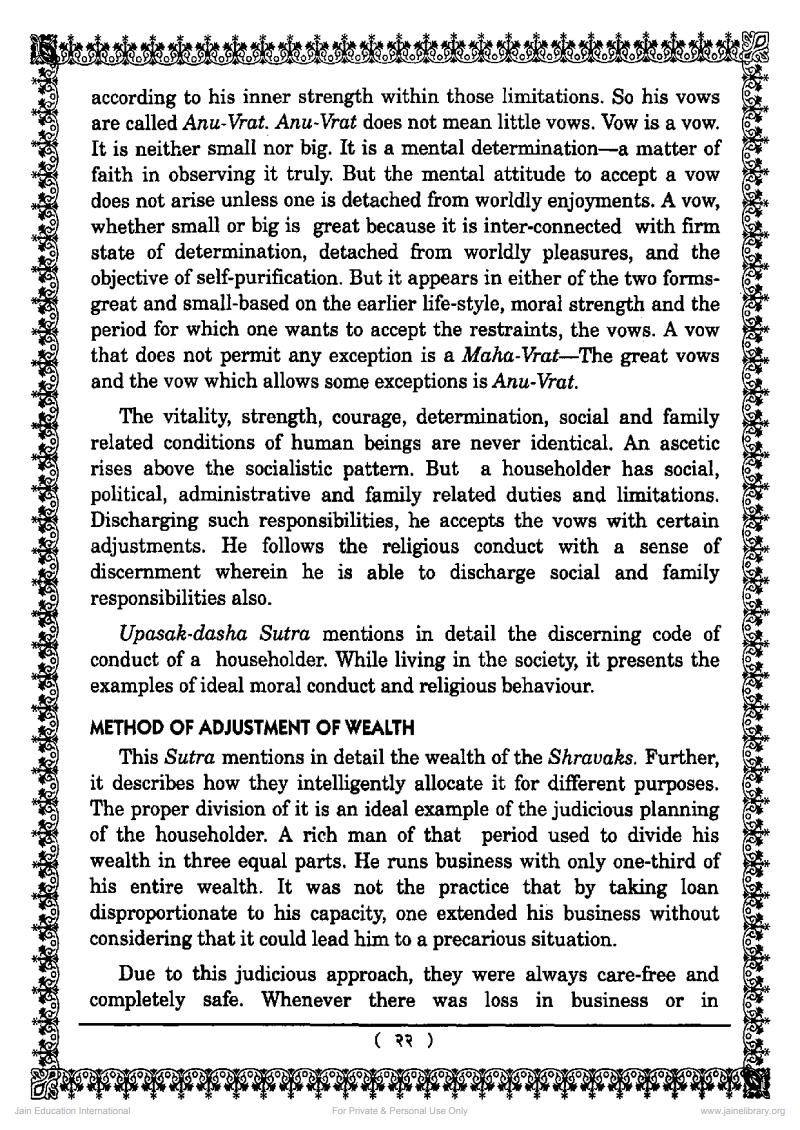S
5 y
LoPAVOo 0 oO PALO PRG OPA O PANTO PAN 0 PANTO DIK O PANTO VAN 0 YANC O VINLO 0 PAC O TAM OVA 0 YANO VASO TAN OVAALO li E
R
according to his inner strength within those limitations. So his vows
are called Anu-Vrat. Anu-Vrat does not mean little vows. Vow is a vow.
3
It is neither small nor big. It is a mental determination—a matter of
O
faith in observing it truly. But the mental attitude to accept a vow T
lay L
does not arise unless one is detached from worldly enjoyments. A vow, O
RWB
o whether small or big is great because it is inter-connected with firm O
X
P E
state of determination, detached from worldly pleasures, and the
O
O
R Z
P objective of self-purification. But it appears in either ofthe two forms- NE
V O
great and small-based on the earlierlife-style, moral strength and the N
P B4
o period for which one wantsto accept the restraints, the vows. A vow O
P W
o that does not permit any exception is a Maha-Vrat—The great vows O
E H
and the vow which allows some exceptions is Anu-Vrat.
O S
N A
I W
T
TO The vitality, strength, courage, determination, social and family GA
L W
A related conditions of human beings are never identical. An ascetic R
O S
N rises above the socialistic pattern. But a householder has social,
A
OF w
political, administrative and family related duties and limitations. R
PAM
O O
Discharging such responsibilities, he accepts the vows with certain R
<TA it
O adjustments. He follows the religious conduct with a sense of S
AFAM y
discernment wherein he is able to discharge social and family S
O
T
)A
iZ responsibilities also. C}
F
O oS
T
M Y
7gOTA Upasak-dasha Sutra mentions in detail the discerning code of OR
AsGST conduct of a householder. While living in the society, it presents the
OF .
O
@PM examples ofideal moral conduct andreligious behaviour. R
O O
PRG
o METHOD OF ADJUSTMENT OF WEALTH O
Y
PRI R
This Sutra mentions in detail the wealth ofthe Shravaks. Further,
o O
S
PY it describes how theyintelligently allocate it for different purposes.
GjFAATO The proper division of it is an ideal example of the judicious planning SWsOR
O O
AL of the householder. A rich man of that period used to divide his
GjP
tO wealth in three equal parts. He runs business with only one-third of ao
5)LOTA his entire wealth. It was not the practice that by taking loan OnWw
o
a
FA disproportionate to his capacity, one extended his business without sw
O o
Ores considering that it could lead him to a precarioussituation. Oe
g S
C]r Due to this judicious approach, they were always care-free and B
o O
Lis completely safe. Whenever there was loss in business or in
o
a
r
( %)
OPW ORY ORYZO TWO ETO N70 0 O INO OO O DW O DW OO INA PIO DA O Od OA ODW/AO ee.
ne
Sart




